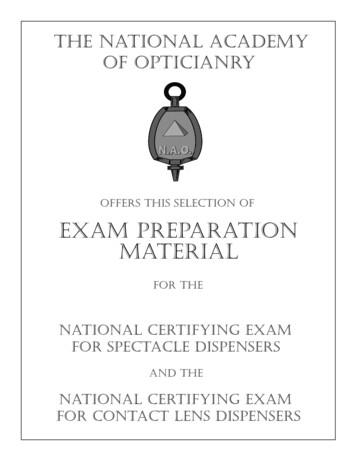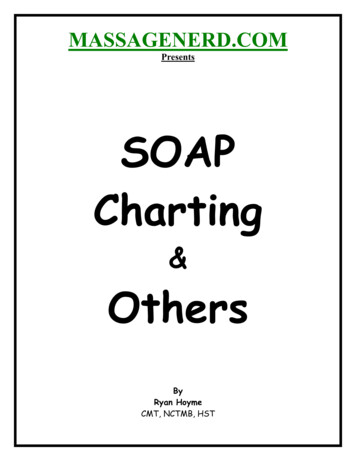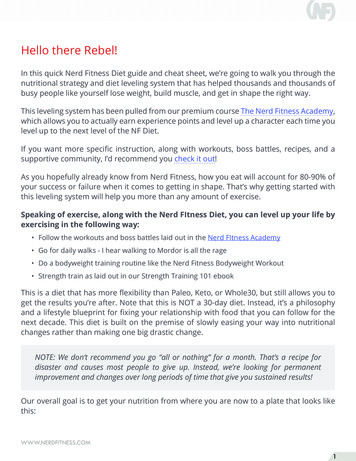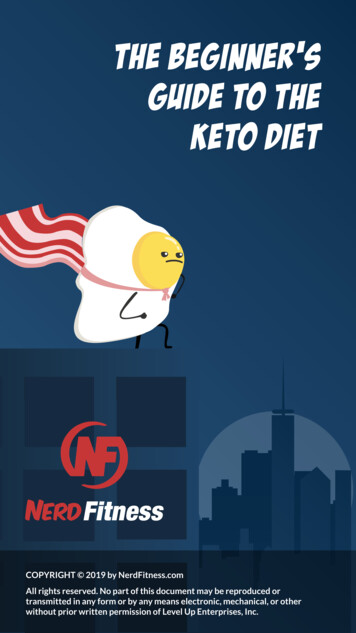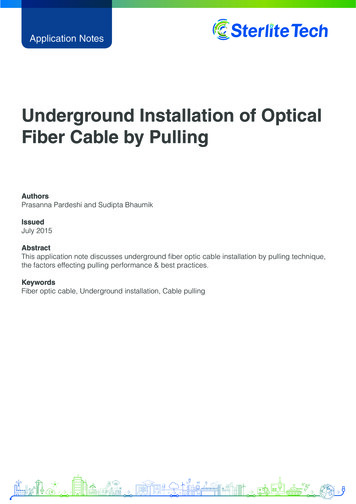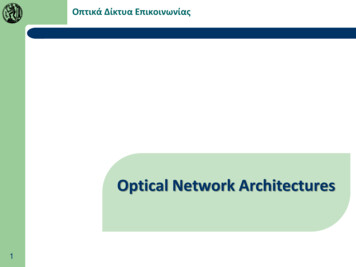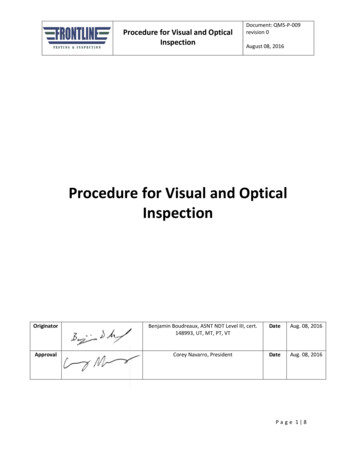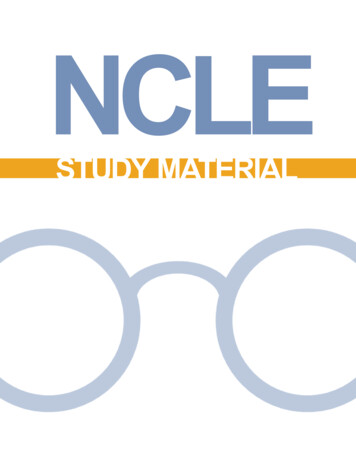
Transcription
NCLESTUDY MATERIAL
Page 3
NCLE PREPMedical FactorsPatient SelectionSystemic drugs. Drugs for gastric ulcers (atropine-like drugs). Birthcontrol pills which can cause rigid lenses to be intolerable and softlenses to be rapidly covered with protein deposits. Pregnancy andmenopause also have similar effects.Handling problems due to Arthritis and other physical conditions.Allergies. A history of hay fever, drug reaction, or skin reactions tocosmetics or perfumes may be a warning to later sensitivity topreservatives in contact lens solutions.Nystagmus is an involuntary, rapid movement or rotation of theeye. Nystagmus is often associated with photophobia. Patientswith a significant refractive error may profit from contact lensesbecause the lenses move with the eye.Page 3
NCLE PREPIntroductionsAnatomical ConsiderationsCorrecting refractive error is the result of the entire intraocularsystem of the eye combining with an extraneous lens to providegood vision. Successful contact lens wear is dependent on this aswell, but the relationship of the contact with the cornea, eyelids,limbus, and tear film, must continue to have a balanced interactionto ultimately provide the vision and comfort the patient expects.This section will give insight into anatomical considerations whenfitting contact lenses.CorneaWhen light strikes the cornea, it bends--or refracts--the incominglight onto the lens. The lens further refocuses that light onto theretina, a layer of light sensing cells lining the back of the eye thatstarts the translation of light into vision. For you to see clearly, lightrays must be focused by the cornea and lens to fall precisely on theretina. The retina converts the light rays into impulses that are sentthrough the optic nerve to the brain, which interprets them asimages.Because the cornea is as smooth and clear as glass, but is strongand durable, it helps the eye in two ways:1.It helps to shield the rest of the eye from germs, dust, and otherharmful matter. The cornea shares this protective task with theeyelids, the eye socket, tears, and the white part of the eye(sclera).2.The cornea acts as the eye's outermost lens. It functions like awindow that controls and focuses the entry of light into the eye. Thecornea contributes between 65-75 percent of the eye's totalfocusing power.The five layers of the cornea are:Anterior EpitheliumBowman’s MembraneCorneal StromaDecements MembraneEndotheliumPage 4
NCLE PREPAnatomical ConsiderationsCornea(continued)EPITHELIUMThe epithelium is the cornea's outermost region, comprising about10 percent of the tissue's thickness. The epithelium functionsprimarily to: (1) block the passage of foreign material, such as dust,water, and bacteria, into the eye and other layers of the cornea;and (2) provide a smooth surface that absorbs oxygen and cellnutrients from tears, then distributes these nutrients to the rest ofthe cornea. The epithelium is filled with thousands of tiny nerveendings that make the cornea extremely sensitive to pain whenrubbed or scratched. The part of the epithelium that serves as thefoundation on which the epithelial cells anchor and organizethemselves is called the basement membrane.BOWMAN’S MEMBRANEThe acellular second layer, which provides strength to the cornea,is Bowman’s Membrane. Because this layer has no regenerativeproperties, scarring may occur as a result of trauma.STROMABeneath Bowman's layer is the stroma, which comprises about 90percent of the cornea's thickness. It consists primarily of water (78percent) and collagen (16 percent), and does not contain any bloodvessels. Collagen gives the cornea its strength, elasticity, and form.The collagen's unique shape, arrangement, and spacing areessential in producing the cornea's light-conducting transparency.Page 5
NCLE PREPAnatomical ConsiderationsCornea(continued)DESCEMET’S MEMBRANEUnder the stroma is Descemet's membrane, a thin but strong sheetof tissue that serves as a protective barrier against infection andinjuries. Descemet's membrane is composed of collagen fibers(different from those of the stroma) and is made by the endothelialcells that lie below it.ENDOTHELIUMThe endothelium is the very back, or posterior, layer of the cornea,consisting of a single layer of flattened cells. These cells are verysusceptible to trauma and pathology, and very rarely regenerate.EyelidsThe palpebra, or eyelids, primarily function to protect the anteriorsurface of the eye from injury. They also aid in regulation of lightreaching the eye. The eyelids also distribute the protective tear filmover the cornea during blinking.The innermost layer of the tear film is the glycocalyx layer. Itconsists mainly of carbohydrates extending from corneal andconjunctival epithelia.The lipid layer is cecreted by the meibomian glands lining the upperand lower eyelid margins. These glands secrete a mixture ofproteins and lipids that forma a liquid at body temperatures. Theeyelids spread lipids throughout the tear film during upwardblinking. Downward blinking returns the lipids to the inferiorreservoir.The third layer of the tear film the aqueous layer is formed byaqueous secretions of the lacrimal glands. Stimulation of thecornea typically increases lacrimation and is know as ‘reflexivelacrimation.’ (Crying in response to burning or painful sensations).The final layer of tear film is the mucoid which forms stabilizes thetrar film and prevents bacteria and debris from adhering to the eye.The layering is not fixed and distinctive, but rater blends into aflowing liquid that coats the corneal surface.Page 6
NCLE PREPAnatomical ConsiderationsEyelids(continued)To provide proper tear flow, the patient must blink at least12 times per minute. An incomplete, or false blink, occurs whenthe eyelids do not meet during the blinking process. This mayresult in a dry lens.The opening between the eyelids is the palpebral fissure.LimbusThe boundary, about 1mm in width, between the cornea and sclera,is the limbus. Part of the corneal nutrients pass through this area.Because of its close proximity to the cornea, the contact lensesmust not bear directly on the limbus. This must be considered formost lens fittings.Page 7
NCLE PREPTear FilmAnatomical ConsiderationsThe tear film is vital for normal corneal function. It has a number ofimportant roles. It moistens and lubricates the anterior surface of the globe.Provides a smooth optical surface, which allows a sharp imageto be focused on the retina.Removes dead corneal cells and bacteria.Protects the cornea against infection, since it contains anenzyme called lysozyme that can destroy bacteria by acting ontheir cell walls.Provides a slight amount of nourishment to the cornealepithelium.Perhaps the two most important factors in successfully adapting toany contact lens is keeping the lens and cornea sufficiently wet andsupplying a sufficient amount of oxygen to the epithelium. A stableand adequate tear film, distributed by the eyelids, fulfills theseneeds.The tear film, which has a ph of about 7.6.Page 8
NCLE PREPAnatomical ConsiderationsTear Film(continued)LIPID LAYERLipids are a fatty hydrophobic material. The lipid layer forms a thin,top layer over the tear film. Lipids help prevent rapid tearevaporation, which could result in keratoconjunctivitis sicca (KCS)or dry eye.AQUEOUS LAYERThe middle layer, or aqueous layer contains ions, sodium,potassium and a concentration of protein.MUCOID LAYERThe innermost, or mucoid, layer of the tear contacts the cornealepithelium.Page 9
NCLE PREPTear Film(continued)Anatomical ConsiderationsBUT, or Break Up Time, indicates the amount of time after ablink it takes for a tear to breakdown. A BUT shorter than 10-12seconds is considered abnormal, may be a contraindication tocontact lens wear, and may mean there is a deficiency in themucoid layer.The Schirmer test is a method for evaluation of tear production.Disposable pieces of dry filter paper (Schirmer strips) are placed onthe eye, and absorb tears. Based on the amount of wickingoccurring on the strip, a normal or abnormal tear production can bedetermined.DeturgenceNormally, the cornea is in a state of partial dehydration known asdeturgence. Water is moved through the cornea by theendothelium and evaporated from the epithelium layer.IsotonicityWhen an equal amount of water flows into the cornea as out, thecornea is isotonic. This is normal and allows the cornea tomaintain its natural thickness.HypertonicityHypertonicity occurs when more water flows out of the cornea thanin, causing corneal thinning. This condition is often due to a highsalt concentration on the cornea.HypotonicityThe cornea is hypotonic when more water flows in than out,resulting in corneal swelling. This typically happens when normalevaporation does not occur.Page 10
NCLE PREPContact Lenses DesignIntroductionIn this section we will be discussing the three basic categories thatcontact lens designs fall into, as well as, all the basic terminologyassociated with contact lens design.Scleral (Haptic) LensWere designed to conform to the shape of the cornea. Theselenses are very difficult to tolerate. This lens is used when othertypes of lenses fail, such as in cases of severe keratoconus, severelids problems, and great amounts of astigmatism.Corneal LensCorneal lenses are the most common design for rigid gaspermeable lenses. The diameter of this lens is smaller than that ofthe cornea. The diameter of the cornea ranges form 10.5mm –12.5mm.Page 11
NCLE PREPContact Lenses DesignSemi-Scleral LensThis type of lens bridges the limbus and lays partially on theconjunctiva tissue overlying the sclera and adjacent to the cornea.Hydrophobic LensesLenses that are composed of materials which will repel water. Anexample of these lenses are PMMA lenses.Hydrophilic LensesLenses that are made of materials that will naturally absorb water.Soft contact lenses are hydrophilic.Wetting AnglesThe angle that the edge of a bead of water makes with the surfaceof a given material. The smaller the angle,.Page 12
NCLE PREPRigid GasPermeableRigid Gas PermeableRigid gas permeable (RGP) is the term used to describe lensesthat are manufactured of a material that is more rigid than softcontact lenses. They are usually worn on a daily wear basis.Today’s rigid gas permeable lenses are much more technologicallyadvanced than the previous polymethylmethacrylate (PMMA) hardlenses. Although there are benefits associated with these lenses,there will also be compromises.RGP lenses are most effective for correcting astigmatism andproducing sharper optics. These lenses can be easily handled andmay have a longer life span than soft lenses.Due to the rigidity of the lens, there is a longer adaptation period.Initial insertion causes more tearing and blinking than experiencedwith a soft lens.PMMAThe PMMA lens was the first hard transparent material to be usedas a contact lens. This lens was known as the “Conventional HardLens” having a long history of acceptance.PMMA lenses gave consistent vision, durability, were easilyfabricated, and spherical lenses could correct up to 3.00 diopters ofcorneal astigmatism.The disadvantage to this lens was its lack of comfort. This lensonly absorbed 1.5% water. There was a poor exchange of gaspermeability causing symptoms such as corneal edema orspectacle blur.Rigid Gas PermeablePage 13
CABNCLE PREPCellulose Acetate Butyrate was originally developed in 1938 byEastman Kodak as a photographic material. It was not until 1974that it was actually used as a contact lens material.The CAB lens wet easier than the PMMA, allowing better tear flowunder the lens. It was a more comfortable lens to wear allowing fora longer wearing schedule. The edge flare, common with thePMMA lens, was eliminated due to the larger fit.The most significant disadvantage to this lens was the poor shaperetention it exhibited. After one year or after hydration the lenscould warp.Silicone-AcrylateThis material was the next generation of rigid gas permeablecontact lens materials. A combination of silicone (38%) and PMMA(65%) was the material composition of this lens. It was developedin 1979 by Syntex Ophthalmics. These lenses are clinically knownas Polycon I or II, Boston Lenses I or II, Menicon O2, Optocryl 60,Paraperm, and B&L Gas Perm.The principal advantage over CAB lenses was its stability enablingthe lens to be made thinner, increasing patient comfort, and oxygentransmission.Fluorocarbon/Fluorocarbon SiliconeAcrylateThis rigid gas permeable lens is made of either pure floropolymeror fluoropolymer combined with silicone.Examples of these lenses are Boston Equalens, Fluoperm 30, 60,90, and Fluorex.Soft Contact LensesIntroductionIn this section we will discuss the various soft contact lensesavailable.Page 14
NCLE PREPThe Food and Drug Administration (FDA) has jurisdiction over thecontact lens industry. The first soft contact lens that was approvedby the FDA in 1971 Initially, soft contact lenses were producedfrom a gel-like material called hydroxyethylmethacrylate HEMMA.There were many advantages to this material such as, greatercomfort, rapid adaptation, lack of spectacle blur, minimal over wearreaction, less flare, less photophobia, and more corneal protection.Although there are many advantages there are a fewdisadvantages. Some of these include lack of durability,susceptibility to protein buildup, impossibility to modify and difficultyto verify.Soft contact lenses are classified as either high or low watercontent. Low water content contact lenses contain less than 39%.Theses lenses provide sufficient oxygen for daily wear. Contactlenses that contain 79% are considered high water content lensesand allow even more oxygen to be transmitted to the cornea.These lenses are usually worn as extended wear.Daily WearThe daily wear lens is worn on a daily basis, but is removed nightlyto be cleaned. Since the lens is removed nightly, the risk of overwearing and eye infections is grea
NCLE PREP. CAB. Cellulose Acetate Butyrate was originally developed in 1938 by Eastman Kodak as a photographic material. It was not until 1974 that it was actually used as a contact lens material. The CAB lens wet easier than the PMMA, allowing better tear flow under the lens. It was a more comfortable lens to wear allowing for a longer wearing schedule. The edge flare, common with the PMMA .
